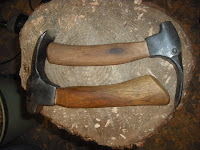 |
| Spoon/thumb rest |
 |
| Scalloped |
Another major method I have seen used, but have not done myself yet, on a little bit larger cracks is to cut out a piece of the bowl containing the crack and then insert a dog bone, butterfly, of bow tie shaped piece of wood to pull the crack, filled with glue, tight and sand smooth. On smaller cracks often the crack is just filled with glue and sanded smooth.
I have also just left a crack in a bowl. This often depends on the type of bowl I have made and who I am trying to sell this bowl to. Sometimes a few small minor cracks can help a bowl look more rustic or antique depending on the buyers taste. I often go for the rustic/worn look with bowls that I intend to sell to my fellow reenactors.
So the debate still remains: What do you do when a bowl cracks? There are many options to choose from and some of them may not work as well as others.






